Coursefinder40
On this page, you find all documents, package deals, and flashcards offered by seller CourseFinder40.
- 290
- 0
- 26
Community
- Followers
- Following
7 Reviews received
320 items
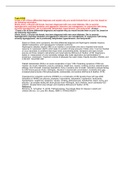
NUR 631 Topic 8 Discussion Question 2
NUR 631 (Advanced Physiology & Pathophysiology) Topic 8 Discussion Question 2 Create a list of three differential diagnoses and explain why you would include them on your list, based on the following information: Sheila Jones, a 28-year-old female, has been diagnosed with new onset diabetes. She is severely hyperglycemic requiring intubation and aggressive intensive care management. In conjunction with being severely hyperglycemic, she is profoundly dehydrated, hypernatremic, and tachycar...
- Package deal
- Other
- • 1 pages •
NUR 631 (Advanced Physiology & Pathophysiology) Topic 8 Discussion Question 2 Create a list of three differential diagnoses and explain why you would include them on your list, based on the following information: Sheila Jones, a 28-year-old female, has been diagnosed with new onset diabetes. She is severely hyperglycemic requiring intubation and aggressive intensive care management. In conjunction with being severely hyperglycemic, she is profoundly dehydrated, hypernatremic, and tachycar...
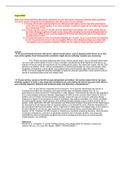
NUR 631 Topic 8 Discussion Question 1
NUR 631 (Advanced Physiology & Pathophysiology) Topic 8 Discussion Question 1 Select two of the following discussion questions for your discussion response. Indicate which questions you have chosen using the format displayed in the “Discussion Forum Sample.” A 78-year-old female presents with fevers, altered mental status, and an elevated white blood count. She has nuchal rigidity. From what possible conditions might she be suffering? Explain your reasoning. A 10-year-old boy comes t...
- Package deal
- Other
- • 1 pages •
NUR 631 (Advanced Physiology & Pathophysiology) Topic 8 Discussion Question 1 Select two of the following discussion questions for your discussion response. Indicate which questions you have chosen using the format displayed in the “Discussion Forum Sample.” A 78-year-old female presents with fevers, altered mental status, and an elevated white blood count. She has nuchal rigidity. From what possible conditions might she be suffering? Explain your reasoning. A 10-year-old boy comes t...
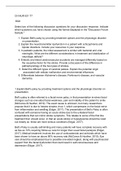
NUR 631 Topic 7 Discussion Question 2
NUR 631 (Advanced Physiology & Pathophysiology) Topic 7 Discussion Question 2 Select two of the following discussion questions for your discussion response. Indicate which questions you have chosen using the format displayed in the “Discussion Forum Sample.” Explain Bell’s palsy by providing treatment options and the physiologic disorder on presentation. Explain the neurotransmitter dysfunction in a patient with schizophrenia and bipolar disorders. Include your resources in your re...
- Package deal
- Other
- • 5 pages •
NUR 631 (Advanced Physiology & Pathophysiology) Topic 7 Discussion Question 2 Select two of the following discussion questions for your discussion response. Indicate which questions you have chosen using the format displayed in the “Discussion Forum Sample.” Explain Bell’s palsy by providing treatment options and the physiologic disorder on presentation. Explain the neurotransmitter dysfunction in a patient with schizophrenia and bipolar disorders. Include your resources in your re...
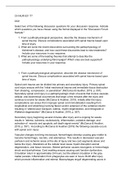
NUR 631 Topic 7 Discussion Question 1
NUR 631 (Advanced Physiology & Pathophysiology) Topic 7 Discussion Question 1 Select two of the following discussion questions for your discussion response. Indicate which questions you have chosen using the format displayed in the “Discussion Forum Sample.” From a pathophysiological perspective, describe the disease mechanism of spinal trauma. Discuss complications associated with spinal trauma based upon time of injury. What are some the recent discoveries surrounding the pathophys...
- Package deal
- Other
- • 4 pages •
NUR 631 (Advanced Physiology & Pathophysiology) Topic 7 Discussion Question 1 Select two of the following discussion questions for your discussion response. Indicate which questions you have chosen using the format displayed in the “Discussion Forum Sample.” From a pathophysiological perspective, describe the disease mechanism of spinal trauma. Discuss complications associated with spinal trauma based upon time of injury. What are some the recent discoveries surrounding the pathophys...
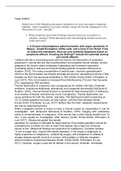
NUR 631 Topic 6 Discussion Question 2
NUR 631 (Advanced Physiology & Pathophysiology) Topic 6 Discussion Question 2 Select two of the following discussion questions for your discussion response. Indicate which questions you have chosen using the format displayed in the “Discussion Forum Sample.” What symptoms and exam findings would prompt you to perform a pituitary workup? What laboratory and neuroimaging studies would you order and why? A 24-year-old postpartum patient presents with vague symptoms of fatigue, weight fl...
- Package deal
- Other
- • 3 pages •
NUR 631 (Advanced Physiology & Pathophysiology) Topic 6 Discussion Question 2 Select two of the following discussion questions for your discussion response. Indicate which questions you have chosen using the format displayed in the “Discussion Forum Sample.” What symptoms and exam findings would prompt you to perform a pituitary workup? What laboratory and neuroimaging studies would you order and why? A 24-year-old postpartum patient presents with vague symptoms of fatigue, weight fl...
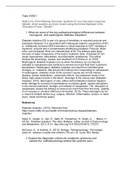
NUR 631 Topic 6 Discussion Question 1
NUR 631 (Advanced Physiology & Pathophysiology) Topic 6 Discussion Question 1 Select one of the following discussion questions for your discussion response. Indicate which question you have chosen using the format displayed in the “Discussion Forum Sample.” What are some of the key pathophysiological differences between neurogenic and nephrogenic diabetes insipidus? Explain the diagnostic criteria for metabolic syndrome and explain the pathophysiology behind the systems seen. Diabet...
- Package deal
- Other
- • 4 pages •
NUR 631 (Advanced Physiology & Pathophysiology) Topic 6 Discussion Question 1 Select one of the following discussion questions for your discussion response. Indicate which question you have chosen using the format displayed in the “Discussion Forum Sample.” What are some of the key pathophysiological differences between neurogenic and nephrogenic diabetes insipidus? Explain the diagnostic criteria for metabolic syndrome and explain the pathophysiology behind the systems seen. Diabet...

NUR 631 Topic 5 Discussion Question 2
NUR 631 (Advanced Physiology & Pathophysiology) Topic 5 Discussion Question 2 Select two of the following discussion questions for your discussion response. Indicate which questions you have chosen using the format displayed in the “Discussion Forum Sample.” What are the associated complications with altered thyroid functionality? Adrenal insufficiency can be induced by steroid treatment. What are associated conditions with adrenal insufficiency and how would you prevent the state of...
- Package deal
- Other
- • 5 pages •
NUR 631 (Advanced Physiology & Pathophysiology) Topic 5 Discussion Question 2 Select two of the following discussion questions for your discussion response. Indicate which questions you have chosen using the format displayed in the “Discussion Forum Sample.” What are the associated complications with altered thyroid functionality? Adrenal insufficiency can be induced by steroid treatment. What are associated conditions with adrenal insufficiency and how would you prevent the state of...

NUR 631 Topic 5 Discussion Question 1
NUR 631 (Advanced Physiology & Pathophysiology) Topic 5 Discussion Question 1 Select two of the following discussion questions for your discussion response. Indicate which questions you have chosen using the format displayed in the “Discussion Forum Sample.” As with all disorders, it is essential to determine the root cause of endocrine disorders. What are primary, secondary, and tertiary disorders? Compare the differences among primary, secondary, and tertiary forms of hyposecretion ...
- Package deal
- Other
- • 3 pages •
NUR 631 (Advanced Physiology & Pathophysiology) Topic 5 Discussion Question 1 Select two of the following discussion questions for your discussion response. Indicate which questions you have chosen using the format displayed in the “Discussion Forum Sample.” As with all disorders, it is essential to determine the root cause of endocrine disorders. What are primary, secondary, and tertiary disorders? Compare the differences among primary, secondary, and tertiary forms of hyposecretion ...
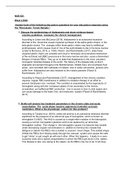
NUR 631 Topic 4 Discussion Question 2
NUR 631 (Advanced Physiology & Pathophysiology) Topic 4 Discussion Question 2 Answer both of the following discussion questions for your discussion response. Discuss the epidemiology of thalassemia and share evidence-based practice guidelines necessary for chronic management. Sickle-cell anemia has treatment parameters in the chronic state and acute exacerbation. The acute phase requires aggressive hydration and pain medication. What is the physiologic pattern for this problem?
- Package deal
- Other
- • 2 pages •
NUR 631 (Advanced Physiology & Pathophysiology) Topic 4 Discussion Question 2 Answer both of the following discussion questions for your discussion response. Discuss the epidemiology of thalassemia and share evidence-based practice guidelines necessary for chronic management. Sickle-cell anemia has treatment parameters in the chronic state and acute exacerbation. The acute phase requires aggressive hydration and pain medication. What is the physiologic pattern for this problem?
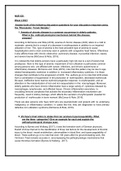
NUR 631 Topic 4 Discussion Question 1
NUR 631 (Advanced Physiology & Pathophysiology) Topic 4 Discussion Question 1 Answer both of the following discussion questions for your discussion response. Anemia of chronic disease is a common occurrence in elderly patients. What is the pathophysiological mechanism behind this disease process? Virchow’s triad refers to states that can produce hypercoagulability. What are the three categories? Give an example for each and explain the pathophysiological changes seen.
- Package deal
- Other
- • 2 pages •
NUR 631 (Advanced Physiology & Pathophysiology) Topic 4 Discussion Question 1 Answer both of the following discussion questions for your discussion response. Anemia of chronic disease is a common occurrence in elderly patients. What is the pathophysiological mechanism behind this disease process? Virchow’s triad refers to states that can produce hypercoagulability. What are the three categories? Give an example for each and explain the pathophysiological changes seen.

NURS 6052 Module 2 Quiz: Is it Quantitative, Qualitative, or Mixed Methods
NURS 6003 Module 6 Assignment: Academic Success and Professional Development Plan Part 6 - Finalizing the Plan
NURS 6003 Module 1 Assignment, Academic Success and Professional Development Plan Part 1 – Developing an Academic and Professional Network
PSY 7713 (Behaviour Analytic Interventions) – Quiz 1 Unit 5 with Answers – 92 out of 100 points
PSY 7713 (Behaviour Analytic Interventions) - Quiz 1 Unit 3 with Answers - 100 out of 100 points